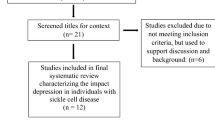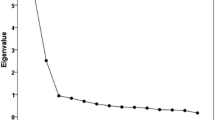Abstract
The current study tested a non-linear model of religious coping among Black patients with Sickle Cell Disease (SCD). We predicted that moderate prayer and church attendance would be associated with less severe affective and sensory ratings of pain, lower levels of psychopathology, and less frequent care utilization. The participants were 67 SCD patients, mean age 36.82 ± 11.47 (range 18–70) of which 45% were men. Using ANOVA procedures, our results indicated a main effect for the frequency of prayer which showed significant differences for anxiety and hostility. Post-hoc t tests revealed that participants who endorsed moderate frequency of prayer reported significantly less anxiety and hostility, relative to participants who reported high or low frequency of prayer. However, participants who endorsed moderate levels of prayer also reported a significantly higher frequency of visits to the emergency department, relative to participants who reported high or low frequency of prayer. However, reports of pain and psychopathology were more linear with participants who reported the highest frequency of church attendance having the highest reports, moderate among those with moderate frequency of church attendance, and lowest among those with infrequent church attendance. These findings challenge and extend the traditional linear conceptualization of religious coping on clinical outcomes among patients with SCD. Directions for future research are discussed.
Similar content being viewed by others
References
Anie, K., Steptoe, A., Ball, S., Dick, M., & Smalling, B. (2002). Coping and health service utilization in a UK study of pediatric sickle cell pain. Archives of Disease in Childhood, 86, 325–329. doi:10.1136/adc.86.5.325.
Ballas, S. K. (1990). Treatment of pain in adults with sickle cell disease. American Journal of Hematology, 34, 49–54. doi:10.1002/ajh.2830340111.
Biggar, H., Forehand, R., Devine, D., Brody, G., Armistead, L., Morse, E., et al. (1999). Women who are HIV infected: The role of religious activity in psychosocial adjustment. AIDS Care, 11, 195. doi:10.1080/09540129948081.
Derogatis, L. R. (1977). SCL-90-R administration, scoring and procedure manual. Baltimore (MD): Clinical Psychometrics Research, General Social Survey.
Edwards, C. L., Scales, M., Loughlin, C., Bennett, G., Harris-Peterson, S., Decastro, L. M., et al. (2005). A brief review of the pathophysiology, associated pain, and psychosocial issues associated with sickle cell disease (SCD). International Journal of Behavioral Medicine, 12, 171–179. doi:10.1207/s15327558ijbm1203_6.
Edwards, C. L., Whitfield, K., Sudhakar, S., Pearce, M., Byrd, G., Wood, M., et al. (2006). Parental substance abuse, reports of chronic pain, and coping in adult patients with sickle cell disease (SCD). Journal of the National Medical Association, 98, 420–428.
Folkman, S., & Moskowitz, J. (2004). Coping: Pitfalls and promise. Annual Review of Psychology, 55, 745–774. doi:10.1146/annurev.psych.55.090902.141456.
Gil, K., Abrams, M., Phillips, G., & Keefe, F. (1989). Sickle cell disease pain: Relation of coping strategies to adjustment. Journal of Consulting and Clinical Psychology, 60, 725–731. doi:10.1037/0022-006X.57.6.725.
Gil, K., Abrams, M., Philips, G., & Williams, D. (1992). Sickle cell disease pain, II. Predicting health care use and activity level at nine-month follow-up. Journal of Consulting and Clinical Psychology, 60, 267–273. doi:10.1037/0022-006X.60.2.267.
Gil, K., Thompson, R., Keith, B., Tota-Faucette, M., Noll, S., & Kinney, T. (1993). Sickle cell disease pain in children and adolescents: Change in pain frequency and coping strategies over time. Journal of Pediatric Psychology, 18, 621–637. doi:10.1093/jpepsy/18.5.621.
Haley, C., Koenig, H., & Bruchett, B. (2001). Relationship between private religious activity and physical functioning in older adults. Journal of Religion and Health, 40, 305–312. doi:10.1023/A:1012561909054.
Harrison, M., Edwards, C. L., Koenig, H., Bosworth, H., DeCastro, L., & Wood, M. (2005). Religiosity/ spirituality and pain in patients with sickle cell disease. The Journal of Nervous and Mental Disease, 193, 250–257. doi:10.1097/01.nmd.0000158375.73779.50.
Hoge, D. (1996). Religion in America: The demographics of belief and affiliation. In E.P. Shafranske (Ed.), Religion and the clinical practice of psychology. (pp. 21–41). Washington, DC: American Psychological Association.
Idler, E., & Kasl, S. (1997). Religion among disabled and nondisabled persons II: Attendance at religious services as a predictor of the course of disability. Journal of Health and Social Behavior, 38, 21–37. doi:10.2307/2955359.
McCrae, J., & Lumley, M. (1998). Health status in sickle cell disease: Examining the roles of pain coping strategies, somatic awareness, and negative affectivity. Journal of Behavioral Medicine, 21, 35–55. doi:10.1023/A:1018763404868.
McDougald, C., Edwards, C. L., Wood, M., Wellington, C., Feliu, M., O’Garo, K., et al. (2008) Coping as predictor of psychiatric functioning and pain in patients with sickle cell disease (SCD). Journal of African American Studies (in press). doi:10.1007/s12111-9051-8.
Melzack, R. (1987). The Short-Form McGill Pain Questionnaire. Pain, 30, 191–197. doi:10.1016/0304-3959(87)91074-8.
Newlin, K., Knafl, K., & Melkus, G. (2002). African-American spirituality: A concept analysis. ANS. Advances in Nursing Science, 25, 57–70.
Pells, J., Presnell, K., Edwards, C. L., et al. (2005). Moderate chronic pain, weight, and dietary intake in African American adult patients with sickle cell disease (SCD). Journal of the National Medical Association, 97, 1622–1629.
Robinson-Smith, G. (2002). Prayer after stroke: Its relationship to quality of life. Journal of Holistic Nursing, 20, 352–366. doi:10.1177/089801002237592.
Schnittker, J. (2001). When is faith enough? The effects of religious involvement on depression. Journal for the Scientific Study of Religion, 19, 393–411. doi:10.1111/0021-8294.00065.
Shaver, P., Lenauer, M., & Sadd, S. (1980). Religiousness, conversions, and subjective well-being: The “healthy-minded” religion of modern American women. The American Journal of Psychiatry, 137, 1563–1568.
Strawbridge, W., Cohen, R., Shema, S., & Kaplan, G. (1997). Frequent attendance at religious services and mortality over 28 years. American Journal of Public Health, 87, 957–961.
Taylor, R., & Chatters, L. (1991). Religious life. In J. S. Jackson (Ed.), Life in Black America (pp. 105–123). Newbury Park, CA: Sage.
van Olphen, J., Schulz, A., Israel, B., Chatters, L., Klem, L., Parker, E., et al. (2003). Religious involvement, social support, and health among African-American women on the east side of Detroit. Journal of General Internal Medicine, 18, 549–557. doi:10.1046/j.1525-1497.2003.21031.x.
Author information
Authors and Affiliations
Corresponding author
Appendix A: Religious Coping Items
Appendix A: Religious Coping Items
-
1
- Church Attendance:
How often do you attend church or other religious meetings?
-
1.
More than once/wk
-
2.
Once a wk
-
3.
A few times a month
-
4.
A few times a year
-
5.
Once a year or less
-
1.
-
2
- Prayer:
How often do you spend time in private religious activities such as prayer, meditation, or Bible study?
-
1.
More than once a day
-
2.
Daily
-
3.
Two or more times /wk
-
4.
Once a week
-
5.
A few times a month
-
6.
Rarely or never
-
1.
Rights and permissions
About this article
Cite this article
O’Connell-Edwards, C.F., Edwards, C.L., Pearce, M. et al. Religious Coping and Pain Associated With Sickle Cell Disease: Exploration of a Non-linear Model. J Afr Am St 13, 1–13 (2009). https://doi.org/10.1007/s12111-008-9063-4
Published:
Issue Date:
DOI: https://doi.org/10.1007/s12111-008-9063-4




